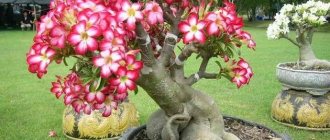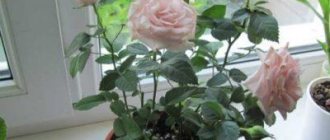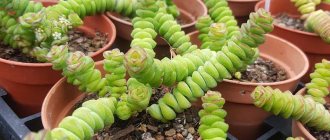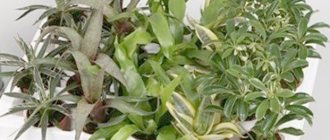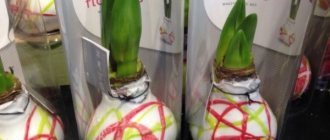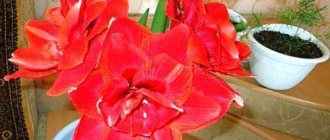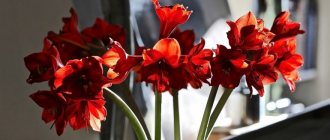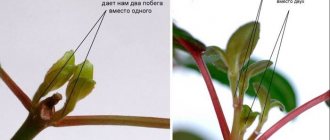Hello, dear readers! We have already written about caring for hippeastrum, today we will talk in more detail about transplanting this plant. When is it recommended to transplant hippeastrum at home and how to do it correctly so that the plants develop normally.
The hippeastrum flower, of course, will need a transplant sooner or later. But you can plant it at any time of the year, and you can even schedule its flowering time. In this case, you will see flowers 5-9 weeks after the first shoot appears. We are talking about planting bulbs purchased in flower shops. They are completely ready for this.
Planting a plant
You will need a specially shaped pot. This is due to the characteristics of the hippeastrum. The root system mainly develops in depth rather than in breadth. The plant blooms faster in conditions of limited soil volume. Therefore, you need to purchase a pot that is narrow and tall. If there is more than three to four centimeters between the wall of the pot and the surface of the bulb, you will have to wait a long time for the flowers.
Plant hippeastrum in ready-made purchased soil for bulbous plants, but it is not difficult to prepare a complete soil mixture yourself. To do this, take one part each of river sand, peat, humus and two parts of turf soil. Mix all these components thoroughly. This way you will get soil with a neutral or very weak alkaline pH reaction, which is very important for hippeastrum.
Important Tips
- Before immersing the bulb in the soil, place it in a container of warm water for two hours.
- At the bottom of the pot, be sure to make a drainage of about three centimeters.
- Fill the soil on top so that the bulb protrudes above the soil surface by a third of its length. Place it strictly in the center of the pot, add soil and moisten it a little.
- You cannot water the plant right away. The first watering is done only after dormancy, when the sprout appears. As the peduncle grows, watering needs to be increased.
- When the sprout reaches fifteen centimeters, moisten the ground once with a weak solution of potassium permanganate. A week after this, feed the hippeastrum with phosphorus fertilizers.
As a rule, flowering occurs a month after the arrow appears. As soon as the hippeastrum begins to bloom, feed the bulb regularly, otherwise it will greatly decrease in size. If you want to extend the flowering time of hippeastrum, then place the pot in a cool but well-lit place.
Features of the flowering period
In winter, hippeastrums begin their flowering period. Numerous varieties of this plant have a wide variety of inflorescence colors from snow-white to purple. Some varieties delight with a pleasant aroma.
Blooming hippeastrum - a gardener's joy
Hippeastrum blooms spectacularly. The flowers are very large, funnel-shaped with a wavy edge of the petals. Collected in inflorescences of several pieces, which sit on tall flower tubular arrows. Mature plants with a large bulb can produce 2 or even 3 arrows at the same time.
Beautiful hippeastrum inflorescence
At the very beginning of flowering, special attention should be paid to the watering regime. This plays a decisive role in the successful growth of arrows and the blooming of flowers. There are a number of important points:
- when the shoots are 6-8 cm high, the plant is watered moderately;
- as the arrows grow, the frequency of watering and the degree of soil moisture increase;
- when the arrow grows to 13-15 cm, the plant is watered with a weak solution of manganese;
- after 5-6 days, mineral phosphorus fertilizers are used.
Transfer
If you dream of getting larger flowers and more lush leaves, you should transplant the hippeastrum directly into the flowerbed for the summer. Here the plant can gain strength until September. There is no need to wait for the first cold nights; it is better to return the plant to home conditions in advance.
Hippeastrum depletes the soil over time, despite fertilizing and proper care. Therefore, it needs to be replanted into new soil at least once every two or three years. But you need to have a good idea of how to transplant hippeastrum. This can be done only a month after flowering has completed. As a rule, the time when you can replant a flower is the end of August. You can also transplant the bulb in December, during the dormant period.
Replant with extreme caution so as not to damage the roots of the plant. After destroying the earthen clod, cut off all the dried roots and sprinkle the cut areas with crushed charcoal. After this, plant the bulb in new soil.
If you bought this flower in a store, then it is not necessary to replant it in the first year. It is quite possible to get by by replacing the top layer of soil without removing the flower from the pot. It is very important to know whether hippeastrum can be replanted during flowering. The answer is clear: under no circumstances.
Features of transplantation and reproduction
How to care for hippeastrum after storage in a separate container or in sawdust? Before replanting already rested bulbs, they must be soaked in cool water. Moreover, only the roots need to be dipped into the liquid. Before planting a plant, you need to choose the right pot. It should be 2 cm larger than the radius of the bulb.
In order to propagate hippeastrum, it is enough to simply separate the children from the main bulb and plant them in separate pots. Caring for them is the same as for an adult flower. If you provide proper care for hippeastrum after flowering, you can ensure that it will bloom at home two or even three times a year.
Bulb damage is not a reason to be upset
It happens that due to negligence, the bulb was damaged or rot formed on it. Don't rush to throw it away. As a rule, the bulb can be saved. To do this, the area of damage or decay must be cut evenly with a sharp knife. Then immerse the bulb in a solution of fungicide, foundationazole or maxim for half an hour. An alternative option is to immerse the bulb in a weak solution of brilliant green for a day. After this, dry it at room temperature for a day.
In order to create a single multi-colored composition from several types of hippeastrum, you will need to purchase a narrow, long and deep pot. In it you can plant several bulbs in a row. The distance between the edges of the bulbs, as well as between the bulbs and the walls of the pot, should be no more than 4 centimeters.
If you strictly follow all these simple rules, then your hippeastrum after transplantation will always be healthy and very beautiful.
You can read more about hippeastrum ha care here.
Hippeastrums are famous for their luxurious flowers of various shapes and colors. And although the flowering of this indoor bulbous crop lasts up to a month and can be repeated up to three times a year, the flowers inevitably fade, and only leathery elongated leaves remain above the soil surface. Then they too may turn yellow.
What to do next when the hippeastrum has faded? How to make the bulbs gain strength and once again please the gardener with a lush bouquet at the top of the peduncle?
Fool the hippeastrum!
Hippeastrum will definitely light up its cavalier stars on your window if you treat such an important person as hippeastrum with due attention and respect.
This plant belongs to the geophytes that spend their dark days in the bulb, and when a favorable moment comes, they are reborn from it, like a butterfly from a pupa. Probably, it is with this property of bulbous plants that my selfless love for them is connected. There was nothing - and suddenly delightful hyacinths bloom on the windowsill, the first feathers of the hippeastrum appear, and in January the expectation of a miracle and spring comes to the house!
I love winter, even after the New Year, I love white snow and winter games, but for some reason, already in January I want spring more and more insistently, and bulbous plants are a great way to bring it into the house!
On top of that, bulbous ones are an original gift for March 8, Valentine's Day, and any holiday. A pot of blooming hippeastrum will successfully replace the most expensive and fashionable bouquet of cut flowers.
What needs to be done to place bright stars in the house of this gentleman? First, select the onion. The hippeastrum bulb should be plump, elastic, smooth, without cracks or wet areas, without rot and mold, it goes without saying. Hippeastrum differs from other beautifully flowering bulbs in that not one, but several flowers appear inside the bulb. Hippeastrum flowers are powerful and bright. Cut arrows can last for 2-3 weeks. Depending on the method of cultivation and maintenance, plants bloom once or twice a year, and their flowering can be left to chance, or you can arrange it for a certain date, this is called forcing. To be honest, I like it better when the hippeastrum blooms in January-February and rests in the garden in the summer. But, as they say, it depends on the taste and color...
Vegetation of hippeastrum after flowering
The flowering of hippeastrum requires enormous strength from the plant, therefore, after the huge flowers wither, the bulb is in dire need of restoration. And this extremely important period with a single flowering usually lasts nine months. If the hippeastrum is transplanted after flowering, you will find that the bulb has noticeably lost weight and the upper scales have lost their elasticity.
Growing leaves and intensive feeding during the growing season will help the plant regain its former strength and lay the beginnings of future flower stalks:
- As the flowers fade, the arrows are cut off, leaving 10–15 cm above the bulb. Then, when the arrow is dry, it is unscrewed with a slight turn around its axis.
- Leaves appear gradually, approximately one every 3–4 weeks.
As during the flowering period, during the growing season the plants are watered abundantly and always fed. Watering is carried out carefully, on soil that has dried up from the previous time, without getting on the foliage and bulb:
- In indoor conditions, you can pour water into the pan, making sure that the moisture does not stagnate and the roots remain healthy.
- If the hippeastrum is planted in the garden after flowering, a shallow trench is made in the soil around the bulb, where watering is carried out.
Fertilizing is carried out in moist soil or combined with watering. Regular application of liquid fertilizers, especially potassium and phosphorus, will help quickly restore strength to the bulb
Caring for hippeastrum after flowering involves feeding at least 2 times a month; for seriously weakened and young plants they are done more frequently, for example, once a week.
Complex formulations for ornamental flowering or bulbous plants can be used as fertilizer.
Hippeastrum care
Suitable conditions for growing hippeastrum, especially in autumn, are the optimal combination of temperature, light, and humidity levels, which are completely opposite during the periods of growth, flowering and dormancy. Its decorative beauty depends on how to care for hippeastrum.
Temperature
Hippeastrums develop at any room temperature, however, 20-25°C is considered the most comfortable for the plant. Avoid sudden temperature changes that will slow down flower growth. During the resting period of the plant (time data - in the table with botanical characteristics) do not allow the temperature to drop below 10°C.
Illumination
Hyperastrum is a sun-loving flower, it is advisable to place it on south-eastern and south-western windows. It tolerates direct sunlight normally, but it is better to provide the hippeastrum with diffused light through transparent tulle. The plant spends eight to ten weeks a year in a dark place, in a cool place (12-14°C). This is a period of rest. In order for the hippeastrum to wake up, the pot is placed on a bright window.
The flower stalks will be even if the flower pot is periodically turned to the sun in different directions. Do this carefully: due to the weight of the flower shoots, the hippeastrum easily loses its balance and topples over.
Proper watering
The amount of moisture depends on the stages of the plant's growing season. With the beginning of the hibernation period, watering is stopped until the leaves dry completely. Only a small amount of water is allowed in the tray to maintain the viability of the bulb and roots. At the moment of awakening, the amount of moisture is increased to moderate (watered no more than twice a month). As the peduncle develops, it is necessary to water the hippeastrum systematically and take into account the following features of the procedure:
- use only warm water;
- do not over-moisten the soil;
- make sure that the earthen ball has time to dry out between waterings;
- Do not allow water to get on the bulb.
Watering should be as natural as possible: in nature, hippeastrums bloom only during the heavy rainy season, and the bulbs “sleep” during drought.
Humidity
Hippeastrum, although it grows in the tropics, is a fan of dry conditions. It does not need spraying or irrigation, since stagonospora spreads quickly with high air humidity. This is one of the most dangerous diseases for indoor hippeastrum. At the same time, it is recommended to wipe its juicy, fleshy leaves from dust with a moistened cotton pad.
Priming
For effective cultivation, light and loose soils with high air and moisture permeability are needed. The ideal soil substrate is: peat, river sand and drainage or deciduous soil in equal proportions. A simple solution is to purchase store-bought soil for begonias. After two to three years, it is advisable to completely renew the soil.
The soil mixture should be as nutritious as possible. Expert florists advise adding compost or well-rotted manure, as well as a small amount of ash.
Top dressing
Feeding is very important, as the bulb accumulates vitality for future flowering. Fertilize hippeastrum every ten days (except for the dormant period). Potassium fertilizers are used, the composition of which depends on the stage of plant life:
- beginning of the growing season - nitrogen-potassium in a ratio of 40:60;
- formation of a peduncle - nitrogen-phosphorus-potassium fertilizing in a ratio of 30:30:40;
- flowering time - phosphorus-potassium fertilizers in a ratio of 40:60.
You cannot fertilize dry soil mixture, this will only harm the flower. The soil must be watered first. Special solutions for bulbous plants, which are diluted strictly according to the instructions, nourish hippeastrum well. The time for the first feeding is when the flower shoot reaches 10-15 cm.
Growing container
The diameter of the hippeastrum bulb is on average 10 cm, it has long roots. To grow a flower you will need a narrow and tall pot, preferably a ceramic one. Focus on the following dimensions: depth - up to 15 cm, width - 5 cm more than the diameter of the bulb. The bottom of the pot must be filled with drainage.
Transfer
It is better to replant hippeastrum in early spring, while completely renewing the soil. It is recommended to change the location of adult plants every two to three years. In summer, the bulbous flower can be transferred to open ground, and with the arrival of autumn, return it to its place. In the first half of September, the plant is dug up, dry scales are cleaned off and treated with copper-containing solutions. The transplantation procedure must be performed very carefully so as not to spoil the voluminous leaves.
Rest period for hippeastrum
Traditionally, the hibernation period for hippeastrum is arranged in the fall and early winter. It takes two to three months for the bulb to recuperate and set flower buds. The exact duration cannot be known in advance, since it depends on the intensity of the previous flowering and the care of the hippeastrum after it.
A sign of readiness for dormancy can be the wilting of leaves on a tight, large bulb. However, today there are a number of varieties and hybrids that practically do not lose leaves. In this case, you can notice that new leaf plates no longer appear:
- At the end of the growing season for hippeastrum, watering is reduced, and in September or October it is completely stopped.
- The last feeding is carried out 4 weeks before the plants are sent into hibernation.
If the hippeastrum retires in September or early October after flowering, then by the New Year holidays you can expect that the strong bulb will produce a new peduncle. For this period of time, the South American winter is simulated for the plant, providing:
- lack of lighting;
- temperature within 12–14 °C;
- low air humidity, not higher than 60%;
- extremely sparing watering to prevent the roots from dying off.
For young, non-blooming bulbs and children, a dormant period is not needed. If plants of different ages grow in the same container, it is better to plant them before hibernation.
This will prevent the plant from being damaged by replanting when it comes out of the dormant period, and will give the bulb additional nutrition. Usually, after flowering, hippeastrums go into “hibernation” and are transplanted in a pot. But you can also dig up the bulbs. In this case, they are stored on their side, without cutting off the foliage and sprinkled with sawdust. The temperature regime is the same, that is, 12–14 °C. Often with this method it is possible to achieve earlier flowering, but there is a risk of losing the bulb due to drying out.
What to do if the faded hippeastrum continues to produce leaves, already in a cool place? The bulb itself will help answer the question:
- If it is dense and has grown over the summer, the plant has completed its rest and is ready to bloom.
- But if its scales are sluggish, the grower made a mistake and sent the bulb into “hibernation” early. It is better to replant such a plant and continue to actively feed and water it.
Only healthy, dense bulbs that have fully recovered during the growing season should be sent to rest.
Such a hippeastrum will wake up on its own in a few weeks, releasing a powerful peduncle or the first leaf.
How to grow hippeastrum - video
Author: Natalya February 21, 2022 Category: Houseplants
In our latitudes, the flowering period of amaryllis begins in August-September. After flowering, amaryllis leaves naturally dry out. In order for this to happen faster, you need to gradually reduce the frequency of watering. The peduncle must be cut off before the onset of the dormant period. After a period of dormancy, leaves of amaryllis and hippeastrum begin to grow again, and the formation of peduncles and buds occurs.
Questions about hippeastrum flowering
Question:
How long does hippeastrum bloom?
On average, the flowering period takes 3 weeks (from the moment the peduncle appears until the buds wither). The flowering period is extended when the bulb blooms with several peduncles (after all, the peduncles do not always bloom at the same time, sometimes one after the other).
Temperature also affects flowering times. At a temperature of deg. 25 The peduncle grows quickly, the bud opens quickly, and the bud quickly fades. Optimum temperature deg. 18-20. There is a little trick: as soon as the bud opens, the hippeastrum can be moved to a cooler place (degree 16), then the flowering will last longer.
Question:
Hippeastrum grows leaves and does not want to bloom. How to achieve flowering?
First of all, you need to think about the conditions under which hippeastrum is kept.
1. The bulb may be too small. Typically, bulbs smaller than 6 cm are children, or bulbs that spent a lot of effort on flowering and are too weak after flowering. It is too early for such bulbs to bloom; they need to increase their volume, i.e. fertilizing (nitrogen-potassium) and light are needed; there is no need to arrange a rest period.
2. For flowering, it is very important that the bulb regains its strength during the growth period and lays a flower arrow (usually the arrow is laid after every 4th leaf).
3. The bulb lacks nutrients. Consider how long ago you replanted your bulb. It is advisable to replant even an adult bulb every year, since during the growth period the hippeastrum consumes all the nutrients in the soil. In addition to replanting, the bulb needs proper feeding to restore its strength. During flowering - phosphorus-potassium and a small nitrogen content, after flowering nitrogen-potassium and a small phosphorus content.
4. Lack of light. Think about what kind of lighting you have. Hippeastrums are light-loving and can be easily placed on a sunny southern window.
With such illumination, during the growth period (spring-summer) they will get stronger and lay a flower arrow, and maybe more than one. A bulb that has not received enough light, for example, has stood on a northern windowsill all spring and summer or, in a place where the sun's rays rarely reach, may not flourish.
5. In what container is the hippeastrum planted? The pot should not be very spacious. The distance from the bulb to the wall of the pot is no more than 3 cm.
6. Don't forget about the rest period. After a rapid period of growth, the bulb needs to rest for two to three months in a cool, dark place.
Question:
The bulb is 3 cm, why doesn’t it bloom?
It's a baby, too small to bloom.
Question:
A third flower stalk has appeared, I’m worried about the bulb. Will she have enough strength?
A well-fed bulb quietly blooms with three peduncles. If you are worried about the onion, then as soon as the bud opens, the peduncle can be cut off and placed in water.
Question:
On the third arrow, the flowers were not as large as on the first two. Why?
I didn't have enough strength. As soon as the buds open, it is better to cut off such a peduncle and place it in water.
Question:
How many flowers can there be on one peduncle?
From 2 to 6. The quantity depends on the age of the bulb and varietal characteristics.
Question:
Why does hippeastrum have a peduncle longer than 80 cm?
Or there is not enough light. The more light, the shorter the peduncle.
Question:
A peduncle has appeared, the bulb has 60 cm leaves. Do I need to trim the leaves?
There is no need to trim the leaves. This is stress; strength will be needed to heal the wound (cut site) and to produce new leaves. Why waste her extra energy? All her energy is now spent on flowering.
Question:
Is it possible to get flowering by a certain date? I want it to bloom for the New Year.
Yes, you can. The calculation is as follows: on average, the dormant period lasts 2.5 months (10 weeks), from the moment the flower shoot appears until the buds open, about 3 weeks pass. In total, it turns out to be 13 weeks (a little more than 3 months). This means that in order to get flowering for the New Year, you need to send the bulb to rest in early October.
Question:
Is it possible to achieve flowering on northern windows?
Hippeastrums are light-loving and feel more comfortable on southern, western, and eastern windows. You can make it bloom on a north, north-west, or north-east window. But the hippeastrum grows the bulb and recovers poorly after flowering, it spends a lot of energy on flowering (the bulb noticeably loses weight), produces long leaves and not so many, peduncles are very long and elongated.
Question:
The peduncle rotates around its axis. Is this normal?
It's okay, he's reaching for the light.
Question:
The buds have withered. When should you remove the peduncle?
In order not to weaken the flower stalk after the buds have withered, you need to cut it off.
Question:
Is it true that it is very difficult to get the next flowering from the Dutch?
It is a myth. Flowering does not depend on the “Dutch”, but on the conditions of detention.
Preparing amaryllis for the dormant period
The dormant period for amaryllis is the end of autumn and the beginning of winter. For hippeastrums, the dormant period begins after the plant has flowered, because hippeastrums can be driven out at any time of the year, and not just at the end of summer or early autumn. Early forcing in autumn or late is possible - then the hippeastrum blooms at the end of winter or beginning of spring. Some varieties bloom even in summer.
But whenever your amaryllis or hippeastrum blooms, it needs a period of rest. So far, only one evergreen species of hippeastrum is known - Hippeastrum Papilio, for which there is no need for a dormant period. The remaining varieties of amaryllis and hippeastrum should rest. If you planted amaryllis or hippeastrum in the ground for the summer, then you need to dig its bulb out of the ground before frost and store it in a cool, dark, dry place.
About the flower
The perennial bulbous plant hippeastrum belongs to the Ammarilis family. It comes from South America, where the wild nature of the Amazon basin has created about 90 of its species. Europe has been familiar with it since the 16th century; when it was first brought, it immediately won the hearts of lovers of beauty. They began to grow it, and then develop new varieties and hybrids. In the 18th century, Carl Linnaeus began a confusion that continues after him to this day: he identified the family and called the flower amaryllis horseman or amaryllis horseman.
Only a hundred years after this, scientists established that amaryllis and hippeastrum are completely different plants, and the similarity between them is only external. Hippeastrum, which translates as “star of the horsemen,” was made into a separate genus. Amaryllis came to us from Africa; there are only 2 species of this plant. But the incorrect name stuck; usually all types of hippeastrum are called amaryllis.
The first hybrid has been known since 1799, and today there are more than 2 thousand varieties and hybrids, approximately 200 are actively cultivated. They differ in size, shape and color of flowers, flowering times, and minor features of experiencing the dormant period. It is difficult to say exactly when hippeastrum began to be cultivated at home, but the hobby of flower growers does not go away, this can be seen from how often new hybrids with more and more refined appearance appear.
The hippeastrum bulb is a thickened stem and scales tightly closed around it. The bulb varies from 5 to 10 cm in diameter, the roots are located along the edge of the bottom, they reach 35 cm in length. The scales are the bases of the assimilating (aerial) leaves; a peduncle grows between them. After the plant reaches sexual maturity, 3 leaves grow, and in the axil of the fourth, an inflorescence is formed on the inside - that is, the cycle consists of 4 leaves and a flower. Each growing season can produce 2 or 3 such cycles, which means that each amaryllis can theoretically bloom 2 times annually. But from the formation of the inflorescence to the actual flowering, 18–20 months pass; each inflorescence will grow and appear above the ground when all the leaves of the corresponding period die off, which means not earlier than the next growing season. By counting all the leaves that formed during the growing season, we can say how many inflorescences were formed during this time.
The funnel-shaped or tubular flower of the hippeastrum grows up to 15 cm long and up to 25 cm in diameter, a strong thick peduncle can reach 70 cm. It is difficult to convey in words the regal beauty of bright red, white, pink, cherry, orange, striped and speckled flowers, which are the main plant decoration. The leaves are linear, dark green, long (up to 70 cm) and wide (4 - 5 cm) and also look good at home.
Leaves are a source of nutrients
However, the amaryllis bulb is not immediately dug up after flowering; you must first allow the leaves to do the important job of supplying the bulb with nutrients.
In the period preceding dormancy, it is necessary to prepare the bulb and give it the opportunity to recover after flowering. The leaves should dry naturally, giving all their strength to the bulb. From mid-September, the frequency of watering amaryllis (or hippeastrum) is reduced. Once the leaves have completely yellowed and died, the plant will go dormant on its own.
How to “deceive” hippeastrum and make it bloom
In order to artificially provoke the flowering of hippeastrum, a technique similar to forcing bulbs such as hyacinths and tulips is used. The actions are performed sequentially:
- From the first months of summer until September, the plants are actively watered and fed with fertilizers every 2 weeks.
- In mid-September, the pots with bulbs are moved to a dark, cool place and left alone until the end of November.
- At the specified time, the plants are placed in a warm place with a temperature of 30-35 ℃. Provide moderate lighting and wait for the arrow to appear.
- When the peduncle hatches, begin to moisten the soil daily with warm water (30 ℃).
- In December, when the arrows appear, the pots are placed in a well-lit place and watering is increased.
- Further care involves regular moistening of the soil and fertilizing.
Following this scheme, the plant is artificially forced to bloom. There are also more drastic methods, such as exposure to sudden temperature changes or abrupt cessation of watering. But the described method allows you to achieve flowering without the slightest damage to the flower and is the most humane.
With some effort you can make hippeastrum bloom
The flowering of hippeastrum is beautiful. One can hope for a positive outcome only if all recommendations for caring for the flower are followed.
Wintering amaryllis and hippeastrum
The main dormant period for amaryllis is 2-3 autumn months. If the plant was planted in open ground for the summer, then after flowering the amaryllis must be dug up and replanted in a pot before frost.
Hippeastrum can be left in the ground for the winter. In general, it is enough to replant these flowers once every 3-4 years. And in order for the hippeastrum in the garden to easily withstand frost, it must be covered with a dense layer of peat or other mulch.
But if you decide to take the hippeastrum indoors for the winter, the main thing is to provide its bulb with a cool temperature within 10-18°C.
Is a transplant necessary after purchase and why?
Many gardeners wonder whether it is necessary to replant hippeastrum bought in a store.
If you purchased a flowering plant (and most likely this is the case), then you definitely can’t . It is worth waiting for the end of flowering, and after that you should start replanting.
Imported flowers go on sale in a special substance. According to international convention, it is prohibited to move land across the state border. Therefore, it is the substance that is used instead of earth, remember this point.
This transport substance is sterilized peat, which does not have the nutrients and minerals necessary for the plant to live and develop. Prolonged presence of roots in such soil can lead to rotting, starvation of the plant and other troubles.
Temperature regime for amaryllis (hippeastrum)
When at rest, amaryllis and hippeastrum bulbs should be kept in a cool room. It is best if the temperature is about 15°C, but a temperature of 10°C is also considered acceptable, and the upper value is 18°C. If it is cooler, the bulb may hurt, and if it drops below 5°C, it may die.
Therefore, if you live in an area where the soil freezes below 5°C in winter, it is better to dig up the bulbs for the winter. This is especially true for amaryllis. A higher temperature than 18ºC during the dormant period may cause the bulb to germinate too quickly.
This is also not very good, since the plant did not have time to rest, and it is complete rest that guarantees the establishment of a healthy flower arrow.
During dormancy, you only need to water the bulb so that it does not dry out - once every month and a half. Moreover, water must be poured into the pan so that in conditions of cool air and excess water the bulb does not rot.
You will know that the recuperation period is over when a flower shoot appears on the amaryllis bulb. But active watering and fertilizing should begin only after this arrow extends to 10 cm. From this moment a new growth cycle of amaryllis or hippeastrum begins. Now you need to learn how to care for amaryllis at home and in the garden, depending on where it will grow.
Hippeastrum needs care after flowering, because it is during this period that the plant actively restores lost strength. The leaves continue to grow and nourish the bulb, so it is necessary to provide all the conditions for the further development of the flower. If everything is done correctly, then the grateful hippeastrum will delight you with beautiful buds not just once a year, but several times.
Difference between hippeastrum and amaryllis
Both plants belong to the same Amaryllidaceae family. At first, both hippeastrum and amaryllis belonged to the genus Amaryllis. Subsequently, taxonomy, due to significant differences in the structure of plants, resulted in two different genera. The botanical name amaryllis went to the species amaryllis belladonna, the rest got the name hippeastrum.
| Signs | Hippeastrum | Amaryllis |
| Number of species | Approximately 50-70 species, although some sources mention up to 85 species | one species Amaryllis Belladonna |
| Origin | subtropics and tropics of America | South Africa |
| Number of chromosomes | X=11. In most cases, incompatible with other genera of the Amaryllis family. | X=11. Freely crosses with other genera of the Amaryllis family, including Crinum, Nerine, Brunsvigia. |
| Evergreen or deciduous | Depends on the species, most species are deciduous, with a pronounced dormant period, but there are species without a pronounced dormant period (evergreen), for example, Hippeastrum Papilio. | With a pronounced dormant period, the leaves are shed during the dormant period. A dormant period is necessary for the development of the flower bud. |
| Flowering period | Usually blooms once a year. The flowering period depends on forcing: early forcing means autumn flowering, late forcing means flowering in winter and spring. Some hippeastrums bloom twice a year, usually blooming again in summer. | End of summer, autumn. Flowering once a year. |
| Peduncle (main difference) | Hollow, cylindrical, up to 90 cm high, the color of the peduncle is usually green, but can be green with purple, gray or brown shades | Not hollow, up to 96 cm high, with a purple tint. |
| Number of flowers on a peduncle | Usually from 2 to 6, but some species have up to 15 flowers with a weak odor or no odor. The number of flowers depends on the species and variety, for example, the species wild Hippeastrum fosteri develops up to 15 flowers on one peduncle, the small-flowered Rapido has up to 9, the small-flowered Jaguar has up to 8, the terry medium-flowered Alfresco has up to 8. | from 6 to 12 fragrant flowers. |
| Color of flowers | Red, pink, orange, yellow, green, cream, white; one-color or two-color; with stripes, veined, speckled. | Shades of pink range from deep pink-red to almost white. |
| Shape of flowers | Various: double, long-tubular, orchid-like, similar in shape to Leopoldii and Reginae, etc. | funnel-shaped |
| Flower size | Depends on the variety and type: from 5 cm to 22 cm | from 9 to 13 cm |
| Perianth petals | 6 similar or different in shape and size (depending on the type) | 6 similar in shape and size |
| Bracts (protective casing of the inflorescence) | 2 | 2 |
| Perianth tube | Depending on the species, it can be very long, up to 15 cm, or very short, 2-4 cm. | short |
| Leaves | Depending on the type, the leaves are green, glossy or matte, silky or hard, long, belt-like. Appear before or simultaneously with the flower arrow. Leaves length up to 90 cm, width 3.5-5 cm. | The leaves are narrow, bright green, glossy. The shape is grooved. Leaf length is up to 60 cm, width up to 3.5 cm. They appear after flowering (i.e. they bloom in a leafless state). |
| Bulb, shape | symmetrical. Depending on the type, the shape can be different, round, round-conical or slightly elongated. | pear-shaped |
| Bulb, diameter (adult, capable of flowering) | 7 cm - more than 10 cm. The size depends on the variety: most wild species, tubular and small-flowered varieties have small bulbs, large-flowered and double-flowered varieties have large bulbs in an adult plant capable of flowering. The size of the bulb depends on the variety (in small-flowered varieties the size of an adult bulb is smaller than in large-flowered ones) | more than 12 cm. |
| Scales | white in color, the structure resembles onion scales, the scale breaks easily (without effort) | grayish in color, have pubescence on the inside (the pubescence looks like cotton wool or cobwebs), it is difficult to tear the scales |
| Seeds | The seed capsule contains about 30-45 flat, black, disc-shaped seeds with flying wings. The embryo is covered with black protective tissue. | The seed capsule contains about 20 thick, bulbous, light pomegranate seeds. |
| Seed germination (germination) | Usually about 2 weeks, sometimes a little more. | About 56 days. |
| Features of children's education | Usually babies appear closer to the drying scales. | An interesting feature in adult bulbs is that children appear between the scales in the middle of the bulb, and several growth points are obtained. |
| Features of cultivation | In indoor conditions it grows and blooms well. Typically, the growing season occurs in spring–summer, the dormant period occurs in autumn, the beginning of winter, and the flowering period occurs in late autumn, winter, and spring. | In indoor conditions it is difficult to grow and bloom, because its biological cycle is disrupted. The plant is native to Africa and blooms when it is spring in Africa, during the rainy season. After flowering it vegetates, and during periods of drought and high temperatures it rests. In our conditions, African spring occurs in autumn, so it blooms here (in Russia) in autumn. During the growth period (in our conditions, winter-spring) it lacks light. The plant is very light-loving. Best grown in the garden in direct sun. The temperature should not be lower than 10 degrees, so in the fall they need to be dug up and put in a warmer, brighter place. |
The article used the experience of forum members: Veta, Severina, Elena Prekrasnaya, Olga Gr, Faust, ITALIA, Lucien, Apsara, Vesna, Simona, Romashka. Thanks for the experience and advice.
Compiled by Elena
Features of the growing season
Hippeastrum is a flower that can shoot out buds with almost complete absence of leaves. But when the plant fades, its green mass, on the contrary, begins to quickly and actively develop, reaching half a meter in length. During flowering, the bulb gives all its strength to the flower and loses weight - you can verify this by pulling it out of the pot after the buds have withered.
The size of the bulbs directly affects the number of future arrows - large specimens can produce several of them. At the same time, they direct all the nutrients to the development of buds. Growing and then fading leaves on the hippeastrum after flowering allow you to replenish the supply of components, so it is especially important to monitor their health.
Variety of varieties
Breeders have managed to develop a huge number of hippeastrum varieties. They are classified according to the size and shape of the flower. Thus, the plants are divided into nine groups: simple large-, medium- and small-flowered, three groups of double-flowered plants with similar flower sizes, seabisters, orchid-like and tubular hybrids. Brief descriptions of popular types can be found in the table.
Table - Brief description of popular types of hippeastrum
| Variety | Group | Short description |
| "Lady Jane" | — Terry large-flowered | — Delicate peach corrugated flowers with pink and yellow splashes; – flower diameter – up to 20 cm |
| "Barbados" (one of the most striking views) | — Terry large-flowered | — Red-burgundy flowers with central white stripes; - inside the flower there are 6 curved pistils |
| "Papilio Butterfly" | — Orchid-like | - Oblong bulb; - the flower looks like a butterfly; - creamy, yellow-green color with central bright crimson stripes |
| "Parrot-like" | — Hybrid | — Grows up to 90 cm; - large onion; - leaves with a gray tint; - cherry flowers with oblong, sharp petals |
| "Charisma" | — Large-flowered simple | — Red flowers with white shading along the edges; - the stamen and pistil are also red; – flower diameter – up to 23 cm |
| "Reticulate" | — Hybrid | — Length – up to 0.5 m; - small onion; - thin leaves; - claw-shaped petals; - lilac-pink flowers; - many dark veins |
How to care for hippeastrum after flowering at home
Constant monitoring of the condition of the flower in the pot and comprehensive care for it guarantee future successful flowering of the hippeastrum. Particular attention should be paid to the arrow with faded buds.
What to do with the peduncle
Under no circumstances should you immediately cut off the arrow at the root; this is quite risky. You can damage the bulb, causing it to rot and die. You should do this with the arrow of a flower - cut it in several stages:
- Fading flowers should be removed immediately, thereby preventing the extraction of useful substances;
- After the flowers wither, the arrow is cut to a height of 10-15 cm above the bulb (a small stump remains);
- Then you need to wait for the arrow to dry completely;
- The dried arrow is painlessly removed - to do this, it is turned around its axis and removed from the pot.
After removing the peduncle, new green leaves will begin to form on the bulb, but their appearance will be quite slow - about 1 piece per month.
How to water
Before you start actively watering the hippeastrum, which will help it quickly restore its lost strength, you need to partially replace the soil. To do this, about 3 cm of the top layer of the old substrate is removed. Instead, new soil of the same composition is poured into the pot (usually the soil consists of turf, leaf soil, humus, sand along with peat in a ratio of 2:1:1:1).
Watering is carried out taking into account the following recommendations:
- You need to make sure that water does not get on the bulb itself and the growing leaves;
- For irrigation, settled water at room temperature is used;
- The soil should be moistened moderately, excluding overwatering (this can cause rotting of the roots and bulbs);
- Instead of top watering, you can use bottom watering, filling the tray.
How to fertilize
Caring for hippeastrum after flowering also includes fertilizing the soil. Typically, fertilizing is carried out together with watering - for this, the complex composition is combined with water, dissolving in it. You can also fertilize moistened soil in a pot.
Pests and diseases
Bulbous plants, which include hippeastrum, are susceptible to diseases. Insect pests also bother him.
The main cause of hippeastrum diseases is excessive watering, as well as sudden temperature changes, incorrectly selected soil mixture, and excessive levels of nitrogen fertilizer. Transplanting the plant into another pot and updating the soil will save you from the appearance of new foci of stagonosporosis.
You can understand what is happening to the plant by four external signs.
- Spots and cracks on the peduncle. Gray rot develops. Fungicide treatment is required.
- Yellowing of leaves. Hippeastrum leaves turn yellow or the color of the flower changes if the plant is affected by aphids or thrips. Systemic insecticides (Fitoverm, Vertimek, Artelik) are used for treatment.
- Red or yellow speckles on leaves. They were caused by spider mites. They get rid of it with acaricides.
- Red streaks and dots on the bulb. A sign of a dangerous disease, stagonospora or red burn, which must be dealt with instantly and with radical methods, otherwise the plant will die. All infected and questionable areas are cut out, including leaves and roots. Bulbs are treated with copper-containing or fungicidal preparations. “Fundazol” or “Fitosporin” are effective. Apart from these traumatic procedures, there is no other way to resuscitate hippeastrum.
The bulbs are processed using protective gloves, avoiding contact of “chemicals” with the skin. The duration of the procedure depends on the severity of the damage to the flower, on average - from five to seven minutes to half an hour. Chemicals are not washed off the bulbs.
How to send hippeastrum “to rest”
From time to time, the hippeastrum needs rest. Therefore, when it has bloomed, then a dormant period is organized for the bulb according to the following scheme:
- The bulb is carefully examined and only if it is dense and healthy can the flower be sent to rest.
- After all the leaves turn yellow and dry out, watering stops.
- The hippeastrum is placed in a place where several conditions are met:
- Lack of direct sunlight, darkness;
- Temperature range within 10-18 degrees Celsius (optimally 15 degrees);
- Without a lot of moisture.
The duration of the dormant period can vary for individual varieties from 1 to 3 months. Some hippeastrum hybrids do not shed leaves and are always in the active phase, and therefore do not require “rest” for the bulb.
During the dormant period, it is recommended to water the plant once - after the earthen clod has completely dried. And then you need to periodically moisten the soil by spraying it with a spray bottle. Hippeastrum should be kept in a dark room all the time. Only after the bulb sends out a peduncle, the plant is placed in the light and normal watering is resumed.
Some gardeners practice alternating periods of flowering and dormancy, which helps achieve more frequent growth of shoots and buds at home. Such hippeastrums can delight their owner several times a year, sometimes even quarterly.
However, it is worth remembering: if the leaves of the hippeastrum do not turn yellow or fall off, then there is no need to force it to sleep.
Many gardeners who have recently acquired a hippeastrum indoor plant? They often ask if he needs a period of rest. The hippeastrum should subside. This will allow you to regulate its flowering period and improve vegetative development.
How to choose a method for propagating hippeastrum
Hippeastrum can be propagated using identical daughter bulbs or seeds.
Seed and vegetative method
If you don’t want to buy seeds, you can pollinate and get seed material from your plant. Without the proper level of knowledge in selection, amazing results should not be expected.
After the plants sown with seeds bloom in a year, the successful options are left
After the seed pod appears, the peduncle is not cut off - they wait for the seeds to ripen. The waiting process makes the bulb weaker, so next year the flowering will most likely be inconspicuous. There is no need to wait, but after harvesting, immediately sow all the seeds to a depth of 0.5-0.8 cm. After 2-3 weeks, seedlings will appear in the mini-greenhouse, which need an abundance of light. You can carefully feed the babies with a weak solution of fertilizers. Young hippeastrums are grown like ordinary indoor flowers, without sending them into a dormant period in the first year.
Reproduction by dividing the bulb and daughter bulbs
If the plant has formed children of about 2 cm, then they can be separated during transplantation. Flowering of hippeastrum grown from a baby will occur in 2-3 years. The plant does not always please with children. If you want to propagate the variety, take a clean, disinfected knife and cut the onion into 2-4 shares, with a small part of the bottom each. Don’t forget to treat all the cuts with charcoal and dry them for 2 days. Each part is planted in perlite or sand with peat, without deepening it.
It is permissible to simply cut the bulb and repeat the manipulations with coal and planting in the soil mixture. Water the planted bulbs through a tray. This method provokes the appearance of children.
The rest period of the hippeastrum - when it occurs and how it proceeds
When and how should hippeastrum be put to sleep and why does hippeastrum need a rest period:
- hippeastrum needs a period of rest to regulate flowering and normal development - any experienced gardener will say this. You need to put to rest those bulbs that bloomed in the spring. Young bulbs (under three years of age) do not need to be sent to rest. In some cases, hippeastrum blooms once in the spring, and a second time closer to October-November. In this case, the hippeastrum bulb is put to rest if it does not send out new leaves after flowering. This can be checked by spreading the middle of the crown at the base of the leaves. If no new forcing is expected there and the hippeastrum does not bloom, then the plant can be prepared for sleep;
- hippeastrum is prepared for the dormant period as follows : it is NOT WATERED AT ALL. They start doing this in mid-September. By the end of September, the plant with its lush crown is moved to a dark and cool place where there is no sun rays at all or their amount is minimal. The room temperature should not rise above 13 degrees. In such conditions, the leaves of the hippeastrum begin to dry out and, as they become dead, they are removed. It is not recommended to cut off the still green leaves and thus forcibly send the hippeastrum into a dormant period. All nutrients from the leaves must go into the bulb. By cutting off the green leaves, you deprive the bulb of a significant supply of nutrients. As a result, the plant, even if it has planted a flowering arrow, will bloom sparingly and instead of 4-5 buds it will throw out only 1 or 2 pieces;
- The dormant period of the hippeastrum begins when it begins to shed its leaves . They lose color and begin to dry out. As a result, the plant loses its entire crown. Hippeastrum without foliage should be kept in a dark and cool place until January-February. At this time, the bulb cannot be watered, otherwise it will rot;
- The dormant period of the hippeastrum ends when it begins to throw out a flower-bearing arrow . If this does not happen, the plant begins to wake up on its own. It is taken out to a warm and well-lit place and carefully watered. In this case, you don’t need a lot of liquid, again, so that the onion doesn’t rot.
Hippeastrums in the garden in summer. In such cases, they are dug up in September and transferred from the soil in pots to a warm room. However, there is no need to stimulate the further development of the plant (growth of a green crown) at home. It is better to immediately move the pot with the plant to a dark and cool place and wait until the flower begins to shed its leaves. During the same period, it is possible to separate the adult bulb from possible children that formed in the summer.
If the hippeastrum photo receives care at home, then it must be separated from the children during transplantation.
Choosing bulbs when purchasing and replanting them
In flower shops you can find different varieties of hippeastrum bulbs. They are sold either in bulk or sold in small technical pots.
When purchasing dry bulbs, they must be carefully inspected.
There should be no traces of mold or rot, seals, redness or dark marks.
The neck and the bulb itself must be strong and dense . The scales should be slightly brown.
If hippeastrums are bought in pots, then a careful inspection is also necessary. The bulb should be strong, the upper scales dry and brown, the roots (they can be seen through the drainage hole) should be white without traces of rot.
If the scales are wet and soft, then the bulb has begun to rot; it is better to refuse such a purchase. If the plant already has leaves, then there should not be any dark or red spots on them.
Planting can be done at any time of the year. You can even predict the flowering of hippeastrum by a certain date (for example, by the New Year). It should be remembered that flowering will occur 4-8 weeks after germination.
And one should take into account the time required for the onion to wake up.
Planting is done in light, permeable soil, rich in organic matter. It is necessary to bury the bulb only two-thirds into the ground. After this, the plant will need heat (from +18 C); watering is not needed until the sprout appears.
How is garden Hibiscus cared for and propagated? Florist advice. And here we’ll look at everything about planting and caring for Hibiscus tree. Important details.
Everything about proper planting and care of Hyacinth can be studied in detail by clicking here.
Large bulbs will benefit from any lighting, but small bulbs will need a bright light or a south-facing window sill.
In order to speed up flowering, it is necessary to select only large bulbs and immerse them in warm water at a temperature of +40 C for 2-3 hours. After this, immediately plant the bulbs in the ground. Flowering of such plants will begin in 20-25 days.
